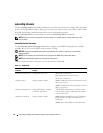
52 omconfig: Managing Components Using the Instrumentation Service
Table 4-1 is a high-level summary of the omconfig command. The columns titled "Command level 2"
and "Command level 3" list the major arguments that can be used with omconfig. "User privilege
required" refers to the type of privilege you need to perform the command, where U=User, P=Power User,
and A=Administrator. "Use" is a very general statement about the actions that can be performed using
omconfig. More details about syntax and use of the command appear later in this section.
Table 4-1. omconfig Command Level 1, Level 2, and Level 3
Command
level 1
Command
level 2
Command
level 3
User privilege
required
Use
omconfig
about U, P, A Shows version number and properties for the
Server Administrator program.
details=true U, P, A Displays information for all of the Server
Administrator programs that are installed.
preferences
cdvformat A Specifies the delimiter for separating data fields
reported in custom delimited format (cdv).
dirservice A Configures the Active Directory service.
snmp A Sets the SNMP root password. Configures
SNMP Set Operations.
useraccess A Determines whether users below the
administrator level are allowed to use Server
Administrator or not.
system
alertaction P, A Determines in advance what actions are to be
taken for warning or failure events on
intrusion, fans, temperatures, voltages, power
supplies, memory, and redundancy.
alertlog P, A Allows the administrator to clear the log.
assetinfo P, A Enters and edits cost of ownership information
for your system, including values for
depreciation, lease, maintenance, service,
and support.
cmdlog P, A Allows the administrator to clear the log.
esmlog P, A Allows the administrator to clear the log.
events P, A Enables and disables SNMP traps.
pedestinations P, A Sets IP addresses for alert destinations.


















